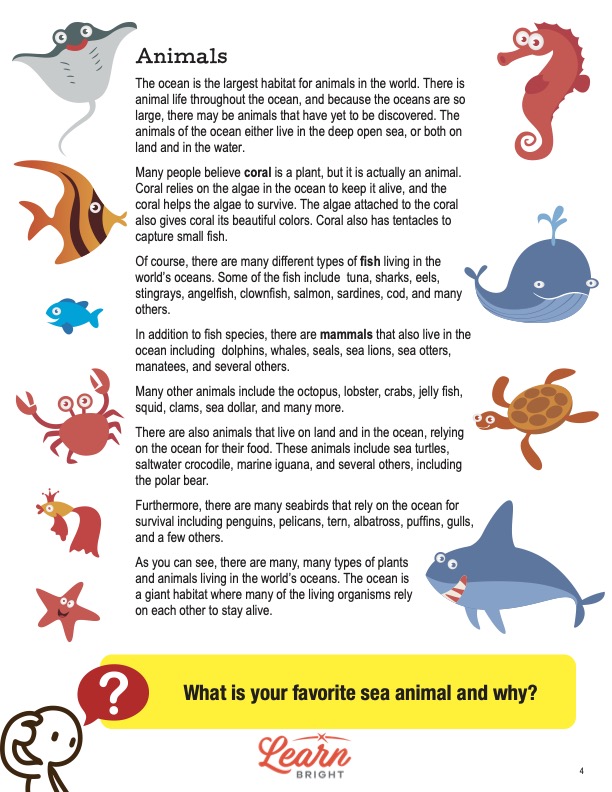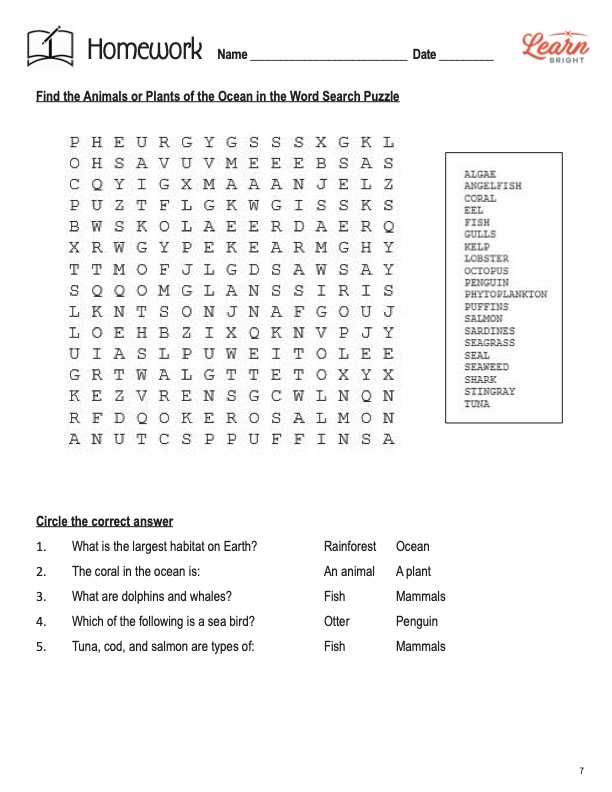Description
What our What Lives in the Ocean lesson plan includes
Lesson Objectives and Overview: What Lives in the Ocean explores the plant and animal life that populate the world’s largest habitats. Students will discover the names of some of these aquatic creatures and will be able to categorize them correctly. They will learn some interesting facts about the ocean and the life forms that call it home. This lesson is for students in 1st grade, 2nd grade, and 3rd grade.
Classroom Procedure
Every lesson plan provides you with a classroom procedure page that outlines a step-by-step guide to follow. You do not have to follow the guide exactly. The guide helps you organize the lesson and details when to hand out worksheets. It also lists information in the yellow box that you might find useful. You will find the lesson objectives, state standards, and number of class sessions the lesson should take to complete in this area. In addition, it describes the supplies you will need as well as what and how you need to prepare beforehand. Apart from the worksheets, the only supplies you will need are colored pencils or crayons. Before the lesson, prepare two large images to display, one of a rainforest and one of the ocean.
Options for Lesson
There are a number of suggestions in the “Options for Lesson” section of the classroom procedure page that you could take advantage of. One idea is to assign a plant or animal for students to research and later present to the class. You could also pair students and have them classify various ocean plants and animals. You may need to gather pictures or simply list on the board some plants and animals for them to classify. Another option is to make bingo cards with pictures instead of numbers and play the game. As another activity or assignment, you could have students research their favorite ocean animal.
Teacher Notes
The paragraph on this page provides a little extra guidance for the lesson. You can use the blank lines to write down any other ideas or thoughts you have before giving the lesson. Feel free to get creative and adjust the lesson plan in whichever ways you want to meet your specific needs.
WHAT LIVES IN THE OCEAN LESSON PLAN CONTENT PAGES
Plants
The What Lives in the Ocean lesson plan contains two pages of content. The world’s oceans are home to thousands upon thousands of different living things. Students will discover that scientists believe there are still a million different species yet to discover in the oceans! The lesson first explores various oceanic plant life.
When it comes to ocean plants, most of them either float on the water’s surface or grow in shallow water. This is because they need sunlight to grow and survive, just like regular plants on land. The parts of the ocean that are the deepest have little to no plant life for this reason.
Students will first learn about algae, a plant-like substance that comes in many forms. One cool fact they will learn is that phytoplankton, a tiny kind of algae, give off more oxygen than any other plant on Earth! Many students have probably heard of seaweed. Seaweed is actually a type of algae, too. It generally floats on the surface of the water. There are many uses for it as well. People use seaweed for food, housing material, ropes, and baskets.
One specific kind of seaweed is kelp. Kelp can reach up to 25 feet in length, which makes it the largest ocean plant in the world. Usually it’s brown and grows and lives on the water’s surface. However, some kelp can be very colorful. It also grows rather quickly. And seagrass is one more ocean plant students will learn about. Seagrass grows in shallow water and lives on the ocean floor. Similar to many land plants, it has roots and flowers.
Animals
Students may be surprised to learn that only 5% of the animals in the world live in the ocean, even though the ocean covers 70% of the earth! They may think only types of fish and turtles can call ocean home. However, the ocean is home to some mammals, birds, and other reptiles and animals. In fact, students will learn that the ocean is the largest animal habitat in the world.
There is animal life throughout the oceans, some in the deep, open sea and others both on land and in the water. There is one kind of animal that a lot of people mistake for a plant: coral. Coral species rely on algae to keep it alive, and they help algae to survive as well. The beautiful colors of a coral come from algae that attaches to it. Coral also have tentacles that help them capture small fish.
Speaking of fish, there are thousands of fish species living in the ocean. Some of these are tuna, sharks, eels, stingrays, sardines, and cod. It may surprise students to learn that dolphins and whales are not types of fish. They are actually mammals. Other mammals that live in the ocean are sea lions, manatees, and sea otters.
More Animals
Students will then learn about more kinds of animals that live in the ocean. They will certainly recognize some of them. These include the octopus, lobster, crabs, jellyfish, squid, clams, and many more. Some animals live on the land as well as in the ocean. They rely on the ocean as a source of food. Sea turtles are a great example. Others include saltwater crocodiles, marine iguanas, and even polar bears.
There are also some bird species that rely on the ocean for survival in one way or another. These include penguins, pelicans, tern, albatross, puffins, gulls, and a few others. By the end of the lesson, students will recognize just how important the ocean is to so many kinds of plant and animal life. This giant habitat helps many living organisms live and survive.
WHAT LIVES IN THE OCEAN LESSON PLAN WORKSHEETS
There are two worksheets in the What Lives in the Ocean lesson plan. You can use the guidelines on the classroom procedure page to know when to hand out each worksheet. You are also welcome to adjust the lesson plan however you need to.
COLORING ACTIVITY WORKSHEET
The activity worksheet includes two pages of pictures of different ocean plants and animals. As the classroom procedure page mentions, you will want to prepare beforehand and ensure you have crayons or colored pencils for the students. You can turn the activity into a kind of quiz if you wish by displaying the pictures without the labels and having students label them.
WHAT LIVES IN THE OCEAN HOMEWORK ASSIGNMENT
There are two parts to the homework assignment. The first section provides a word search puzzle with 20 words to find. The second section lists five prompts. There are two answer options for each prompt. Students will choose the correct answer and circle it. You can decide to allow or not allow them to use the content pages as reference.
Worksheet Answer Key
At the end of the lesson plan, there is an answer key for the homework assignment. The page highlights in red where all the words are in the word search of the first section and the correct options in the second section. If you choose to administer the lesson pages to your students via PDF, you will need to save a new file that omits the answer key page. Otherwise, you can simply print out the applicable pages and keep this one as reference for yourself when grading assignments.










